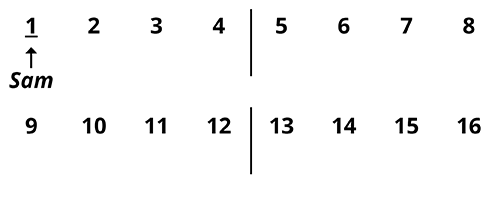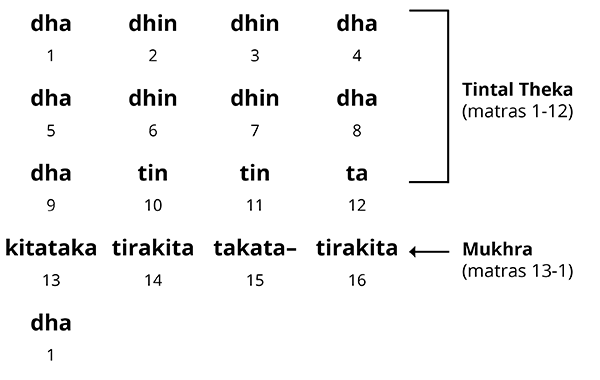Sam – सम
Quick Definition: The first matra (beat) of any tal.
Literal Meaning: even; level; equal
Sam Example
The sam in tintal:

Sam: The Beginning and End of a Tal’s Cycle
Sam is simply the first matra (beat) of any tal. But sam has a special importance in a tal’s cycle; it is both the end of one cycle, and the beginning of the next.
If I ask you, "Where is the end of a 16-beat cycle?", you might say on the 16th beat, or at the very end of the 16th beat, just before the 1. But most Indians would say that it ends on the 1.
This doesn’t mean that every sam is technically a part of the previous cycle. It is not. But it shows us how Indian musician think about sam, and how one cycle flows into the next. For this reason, sam is usally included in demonstrations of a tal or a composition.
Listen to Ravi Shankar and Chaturlal’s demonstration of a single cycle of tintal. Notice how it ends on sam:
In fact, most tabla composition demonstrations will include sam, even if it is played for only one cycle. For some composition demonstrations on this site, such as kayda, rela, and bant, I decided not to include sam to avoid confusion. But most players would normally include sam.
And cadential forms like the tihai, tukra, chakradar, mukhra, etc. must include the sam because the last dha almost always finishes on sam, and is a part of the composition.
We can see this clearly with simple forms like the mukhra. A mukhra is a short cadential phrase which builds up to the sam.
In the demonstration below, the cycle begins with the tintal theka for matras 1-12. A mukhra is then played from matras 13-1 using the phrase kitataka tirakita takata– tirakita dha. Notice how the last dha is both the end of the mukhra, and the beginning of the next cycle of the tal:

(from 4-Matra Mukhra 1)
Sam in Performance
In the sections on matra and tali-khali, I noted that the music does not always clearly show the matra, or follow the vibhags. But musicians will regularly come back to the sam, sometimes in the middle of a long improvisation. This has a way of bringing the music back to the cycle.
In accompaniment, sam is a kind of home beat for both the soloist and the tabla player, where the two artists will sometimes come together, though not always.
Sometimes this coming together on sam may be obvious. Other times it can be very subtle. Sometimes the artists will simply look at each other and nod together on sam. And many times, sam is not stressed at all.
Watch the following short piece from Lal Mani Misra and Chhotelal Misra (vichitra veena with tabla). It begins with a short introductory tabla solo, followed by improvisation by Lal Mani, and then another short tabla solo.
The performance is in tintal vilambit (16 beats, slow tempo), and I have put vibhag indicators to show the tal. If you don’t understand these yet, just look for the X, which indicates sam:
In tabla solo, tabla players will regularly build up to the sam with cadential phrases of all kinds. They will also often begin new variations, change speeds, and finish major sections of the solo on sam, usually with a tihai.
Learning to follow a complete tabla solo takes time. If you are new to classical tabla, I suggest listening to individual demonstrations on this site and pay attention to the focus on sam. The cadential forms mentioned above are a good place to start (tihai, tukra, chakradar, mukhra, paran, and uthan).
You can also listen to short solo demonstrations of theme-and-variation forms like this beginner kayda solo. Notice how speed and variation changes all take place on sam.
References
Clayton, Martin. Time in Indian Music: Rhythm, Metre, and Form in North Indian Rāg Performance. Oxford: Oxford University Press, 2000.
Misra, Chhote Lal. Tal Prabandh. New Delhi: Kanishka Publishers, 2006. (Hindi)
Recordings
Misra, Lalmani & Misra, Chhotelal. (1978). Rag Sindura. On Celestial Music of Pandit Lalmani Misra [DVD]. Sonoma State University, Rohnert Park. (2006). Listen online
Shankar, Ravi. An Introduction to Indian Music. On The Sounds of India. New York: Columbia (1958; reissued 1968). Listen online